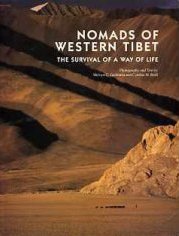 Nomads of Western Tibet
Nomads of Western Tibet

Bellissimo testo con fotografie interessanti sulle popolazioni fra Lhasa ed Il Kailash. Peccato che per svolgere il suo lavoro il prof. Goldstein abbia venduto l'anima ai Cinesi.
==============================
If you've ever enjoyed a National Geographic article -- wonderful photographs, fascinating subject -- but felt that it was too short, with nowhere near enough text, and have been left feeling still hungry to know more ... well, this book is for you.
The photographs are sumptuous, reflecting the training and support provided by the National Geographic Society to the anthropologist-authors, experts on Tibet and other high altitude regions. For this book, they selected 212 images from about 10,000 slides taken during 16 months of field work from 1986-88. The results are stunning, and I only wish the best were available as large prints for framing.
If you have seen the documentary film (available on DVD/video) "Saltmen of Tibet", this book provides a much expanded look at the life of the same society. The landscape is the same also, although more spectacular since it reaches from the plains into the surrounding mountains. The book and film make an interesting pair, nicely complementing each other.
The subjects are some half-million nomadic pastoralists living in the Changtang region of Western Tibet, a high altitude plateau where the climate is too severe and unpredictable for agriculture and the economy has for centuries, perhaps millenia, centered around herding sheep, goats and yaks. Their culture was integrated with the broader Tibetan society, through direct governance and economic ties, yet remained distinct and distinctive. Far from the primitive small bands of egalitarian herders one might imagine, there is substantial stratification of wealth and class. The book describes the traditional economic and social life, something of the traditional history, and also the history of interaction with and subjugation to the Chinese.
The style is engaging, a cross between the narrative story of the expedition and topically organized description (e.g., "Dairy Products", "The Salt Trek", "Economic and Social Change Under the New Policies"). In addition to the many simply beautiful pictures of the landscape, herds and wildlife, there are numerous photographs of the daily activities such as butter and cheese making, hay cutting, or just an old woman sitting in the sun with her rosary.
In short, highly recommended to anyone with an interest in Tibet, nomadic cultures, or the high regions of the earth.
|